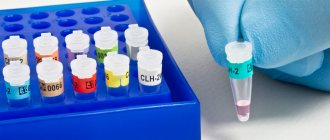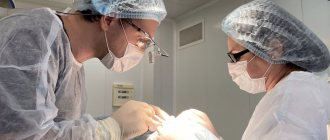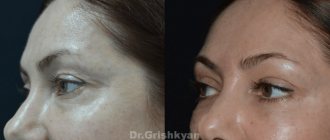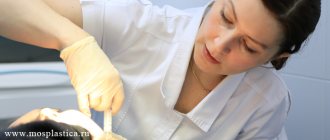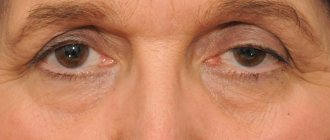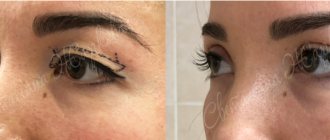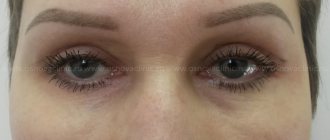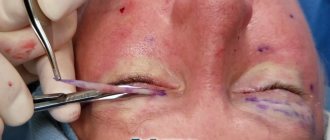Any surgical intervention that involves cutting tissue leaves behind traces. Scars also form after eyelid blepharoplasty. Another question is whether it is possible to reduce their severity, and how to prevent the appearance of unsightly colloidal scars. To date, several effective methods for eliminating postoperative scars have been developed.
Patients, of course, are concerned about whether scars will remain after blepharoplasty. Postoperative sutures are the inevitable consequences of surgical procedures in which skin incisions are made. For successful wound healing, the surgeon must suture the incision to achieve proper tissue union and healing of the wound. Another question is what the scars will look like after blepharoplasty. This depends on several factors:
- physiological characteristics of the patient’s body;
- professional training of a surgeon;
- proper care of sutures after surgery.
With a successful operation without complications, the scars after upper blepharoplasty look as shown in the photo:
As you can see, they are a thin light strip that easily hides in the folds of the skin. Modern techniques allow specialists to make incisions in such a way that after their healing there are no traces left at all, only the patient herself knows about them.
Scars after blepharoplasty are inevitable!
Healing time for scars after blepharoplasty
The average duration of a blepharoplasty operation is 2 hours. If the patient feels satisfactory, he may be allowed to go home, but only accompanied by someone close to him. On the 2nd day, postoperative symptoms appear in the form of pain, swelling and visible bruises. The patient's eyes look like this:
To quickly eliminate traces of damage to tissues and blood vessels, it is recommended to apply cold compresses to the seams. The procedures are carried out over 3-4 days, then a period of gradual recovery begins, which consists of the following stages:
- The exudative phase is characterized by signs of inflammation, swelling and redness of the eyelids. At this time, you need to keep your eyes calm, avoid physical stress, and monitor the hygiene of your stitches.
- From the 1st to the 4th week, granulation (the beginning of healing) of the incisions occurs. In the suture area, new tissue begins to form with the production of collagen and elastin. Scars after blepharoplasty of the upper eyelids become pink.
- Seam thickening and scar formation occurs 1-3 months after surgery. The scar becomes thinner and lighter. If during the first stages of healing there were violations of the regime or individual complications arose, there is a risk of the formation of keloid and hypertrophic scars.
- At 4-10 months after the operation, the process of scar maturation occurs, its edges become denser, smoother, and acquire a light shade.
We have provided average statistical data on the healing time of scars. Correction to a smaller or larger direction is usually associated with the individual reaction of the patient’s body to surgical intervention. Much depends on the type of skin.
Prevention of complications after blepharoplasty
After excision of the eyelid, the sutures are removed for 3-5 days. During this time, a scar begins to form - experts warn that healing of the tissue will take at least a month, but the patient’s anxiety is quite understandable: no one wants to walk around with swelling and scars on their face.
Prevention of unpleasant consequences is important and necessary, but there is no need to rush into it - an anti-scar remedy on an unhealed wound destroys the collagen that has begun to form, which is why the scar will become atrophic. It is better to wait two weeks - during this period the wound should heal. Applying anti-scarring agents to a fresh wound is strictly prohibited.
The stages of scarring go like this:
- The exudative period is the first week after surgery. There are “obvious” side effects: swelling, bruising, redness of the eyelids. It is important to ensure that the suture does not come apart and infection does not get into the wound. To do this, the injured area is lubricated with healing creams and treated with antiseptics.
- Granulation. After the suture is removed, the wound heals, new connective tissue grows with a noticeable network of blood vessels. You can make applications with special means for healing sutures after surgery in a thin layer.
- Bleaching. 2-3 months after blepharoplasty, the scar turns into a barely noticeable white line. At this stage, ointments are used to resolve scars after blepharoplasty: by application (simply smeared) or using physiotherapy. Anti-scarring gel/ointment is applied in a thin layer to clean, dry skin 2-3 times a day.
At each stage, it is very important to keep the problem area clean - if an infection occurs, complications cannot be avoided.
To prevent unpleasant consequences, any plastic surgeon advises following simple rules:
- do not touch the scar with your hands, do not rub or stretch the skin around it;
- do not allow ultraviolet radiation on the damaged area - refrain from going to the solarium and bright summer sun until the scar heals, use sunscreen;
- do not overload your body with physical activity and refuse to visit baths and saunas - excessive sweating can be harmful;
- do not take a hot bath or wet the stitches;
- You should limit your intake of salt in food - the seasoning retains moisture in the body, which causes swelling;
- it is necessary to give up bad habits such as smoking and alcohol.
Keloid scars are quite a rare occurrence after blepharoplasty, however, they still occur in surgical practice.
Prevention of scars with Fermencol gel
Fermenkol gel can be used 2-3 weeks after surgery , when the wound is completely healed and the crust falls off naturally. It contains 9 collagenase enzymes - a substance obtained from the pancreas of Kamchatka crabs. Collagenase acts selectively on pathological collagen in the dermis: excess collagen is destroyed to the simplest molecules, due to which the scar gradually smoothes out and becomes normotrophic. Thus, in the tissues of the epidermis, excess collagen is broken down into simple molecules, the scar gradually disappears and healthy tissue is born.
To prevent the formation of a pathological scar, as well as to accelerate the process of skin regeneration (renewal), it is recommended to apply Fermencol to a healed wound in a thin layer 2-3 times a day for a month. Before using the gel, the seam is treated with a soap solution or antiseptic.
Find out which method of correcting scars and stretch marks is optimal for you!
doctor Svetlana Viktorovna Ogorodnikova.
doctor
Patients notice the first results after 2 weeks of regular use : the texture and color of the skin are evened out, and the healthy framework of the dermis is restored.
What can disrupt the healing process?
After suturing, the blood flow to the damaged tissues increases, which provokes the formation of edema, which can be felt as “nodules” or “bumps”. This process is normal, and with the gradual resorption of the threads everything disappears. Violations can be caused by:
- stagnation of fluid in tissues, occurring due to slow blood flow against the background of excessive tissue swelling;
- problems with the patient's immune system;
- a poorly formed seam when the threads lie close to the surface of the epidermis.
Most often, the patient is faced with the latter factor, when the resorption of the threads is uneven. Some of their parts are cut through on the surface, which causes poor healing of the incisions. Therapeutic massage helps remove excess swelling. It should be carried out by a specialist who knows how to properly direct the outflow of lymph and venous blood, and activate blood flow through the arteries. The duration of the procedures and their frequency must be determined by the surgeon.
If the healing process is slow, you should see the surgeon who performed the operation. The doctor will give you the necessary recommendations to correct the situation.
Treatment of sutures after blepharoplasty
The operating surgeon will tell you how to treat sutures after blepharoplasty. There are many drugs on the pharmaceutical market that accelerate the process of tissue regeneration. Also, these drugs promote the formation of smooth fusions of the skin of the eyelids, completely eliminating the possibility of the formation of rough scar tissue and so-called nodules.
Nodules are small lumps that can form during the healing process of a wound where the suture thread has penetrated.
Most often, home treatment of the wound is not required, since the junction is completely covered with a strip (plaster). The surgeon disinfects the wound immediately after the operation, so the likelihood of infection is extremely low. But if severe redness and soreness appear, then you should consult a doctor. There may have been an infection.
After the sutures are removed, ointments and gels can be prescribed to accelerate skin regeneration and prevent the formation of rough scar tissue. For example, Contractubex. Its use allows the healing process to proceed faster. After transconjunctival blepharoplasty, eye drops with a moisturizing effect (Artificial tear, Oftagel, Oftolik) can be prescribed. The drug is recommended by the surgeon and there is no need to select it yourself.
You can read a lot of advice on what to apply to your eyes after blepharoplasty on the forums. Patients willingly share information about the medications prescribed to them. But it is better to check with your doctor whether it is worth using this or that remedy.
Location of scars on the eyelids
If blepharoplasty was done on the lower eyelids, then the scars from it are located along the ciliary edge of the eye. As a rule, they heal well and become almost invisible over time. When lifting sagging upper eyelids, the seam is located in the folds of the skin and 2 weeks after the operation it is already difficult to notice. If complications arise, the eyelids swell, an inflammatory process develops, and the scar does not heal for a long time. This is what a scar after blepharoplasty should look like:
Outline of the incisions and where the sutures are located after surgery
They form in different places, depending on the type of surgical intervention. In traditional lower eyelid surgery, the outline of the incisions is made slightly below the ciliary edge; in upper blepharoplasty, the contour of the incisions is made at the site where the skin tissue attaches to the levator palpebral muscle.
If the cosmetic procedure is circular, then the incisions are made simultaneously on the lower and upper eyelids. Incisions are made in as inconspicuous places as possible. There will also be two seams. They are performed with intradermal stitches.
The outline of the incisions is made along the natural folds of the skin. The sutures after surgery are placed intradermally. Cosmetic stitches heal and leave a thin scar, which becomes invisible by the end of the 3-month rehabilitation period.
There are no scars with the transconjunctival procedure. This operation is performed through an internal incision in the conjunctiva, so the consequences of the procedure are invisible.
During laser treatment, incisions are not made on the upper and lower eyelids. Areas requiring correction are targeted to a laser beam. The treated areas heal quickly and new tissue appears. The cells continue to renew for a month, but a positive result becomes noticeable after 7 days.
We recommend reading: How to relieve swelling after blepharoplasty
Blepharoplasty of the eyelids called “sangapuri” involves the removal of the epicanthus in the inner corner of the eye. Excess fat tissue is removed. A similar procedure is performed on Asian women. There are sutures, they are created along the muscle aponeuroses. As a result, it is not visible, creating the appearance of a double fold.
Scar Prevention
Following the recommendations of specialists will help to avoid unwanted manifestations in the form of proliferation of connective tissues and the formation of a keloid scar:
- do not rub or stretch the skin in the scar area;
- Until the incisions are completely healed, protect your eyes from ultraviolet radiation (sun, solarium);
- avoid physical activity;
- do not go to the sauna and bathhouse;
- When washing your hair and taking a shower, make sure that the water is not very hot, do not let it get on the seams;
- reduce the amount of salty foods so as not to provoke the formation of edema.
Pay attention to your doctor's advice and follow it strictly. Use ointments and other products that your specialist recommends to remove scars after blepharoplasty.
How skin is restored
The second day after the operation - the eyelids were very swollen and red. Eyes are sensitive to light.
On the 5th day the redness disappeared. There is still swelling. You can use ointments to reduce swelling and cold compresses.
On the 7th day the sutures are removed. Its location is red, visible to others. Hematomas are still present
On day 8 there is practically no swelling. In some cases, swelling remains for several months. It depends on the type of surgery, skin and other factors.
How to speed up the healing of scars after blepharoplasty?
To reduce the healing time of scars, patients undergo various physiotherapeutic procedures: ultrasound, lymphatic drainage, microcurrent therapy. They stimulate cell regeneration and remove swelling. Dorsanval is considered one of the most effective procedures . During this procedure, the mucous membranes of the eye and skin are exposed to high-frequency currents. Penetrating into the deep layers of the epidermis, the currents irritate the nerve endings, causing acceleration of blood circulation in the operated area. Tissues are actively saturated with oxygen, which enhances their regeneration process.
For lasting results, 15-30 dorsanval procedures are performed. During the first session, slight swelling and hyperemia may appear, but they usually go away after a few hours. This is a natural reaction to the effects of currents and should not be feared. In the photo the scar after blepharoplasty is in perfect condition:
How to remove scars after blepharoplasty using traditional methods?
If after blepharoplasty there are long scars, and you are not ready for radical methods, you can use the traditional methods presented in the table:
| Product name | Cooking method |
| Herbal collection | Take dry chamomile, nettle leaves, yarrow, calendula, St. John's wort in equal parts. Pour water (250 ml of boiling water) over the herbs and leave in a heat bath for 65 minutes. After this, the composition is filtered. A piece of linen cloth is soaked in the prepared preparation and applied to the scars. The lotion is kept for 2 hours. |
| Wax-olive mixture | Olive oil (220 ml) is poured into a pan, 50 g of high-quality beeswax is added. The mixture is placed on low heat for 10-12 minutes. After this, the composition is cooled, a linen or cotton napkin is soaked in it, and applied to the scars. The procedure is carried out at least twice a day for 60 days. |
| Parsley tincture | Chop the parsley and pour boiling water (1 cup). The product is left for 15 minutes, then the composition is frozen, divided into small portions. Ice cubes are used to wipe the scar twice a day. Duration of therapy is 3 months. |
| Marshmallow tincture | Finely chop 15 g of marshmallow root, add 250 ml of cold water and leave for 5-7 hours. After the specified time, use the infusion to treat scars every 3-4 hours. In the absence of marshmallow, it is replaced with mint or lemon balm. |
| Melon mask | Take 12-20 melon seeds, 2 eggshells, 5 ml of olive oil. The seeds are dried, crushed, then all components are mixed. The prepared mask is applied to the scar and wrapped with a bandage. The course of treatment is 1 month. |
It is recommended to use traditional medicine only after consulting a doctor. They do not guarantee a quick result, but after a course of treatment they can reduce the appearance of scars.
External remedies for scar healing
The pharmaceutical industry produces a range of creams and gels that actively affect epidermal cells, which can significantly reduce the severity of scars after operations. The Contratubeks gel, which is capable of dissolving rough tissue and smoothing scars, has earned a good assessment from experts. Doctors recommend using it as soon as the stitches are removed. In addition, you can use other external preparations:
- Dermatix gel - has a high softening effect, prevents tissue hardening, smoothes out uneven scars.
- Zeraderm accelerates recovery processes, improves blood flow, and nourishes skin cells with oxygen.
- Kelofibrase prevents inflammation of scars and normalizes the water balance of the skin.
- Scarguard – forming a protective film, retains moisture, prevents tissue from drying out, softens scars.
Consult with your doctor about the choice of external scar smoothing agent. Some components of creams and gels can cause allergies and irritation.
If there are scars at the suture site
Sutures after surgery are visible only to a plastic surgeon, unless the skin is too thick or they come apart after the procedure.
Fortunately, this rarely happens, only among doctors at the beginning of their career growth. Visible scars are the result of an incorrectly performed procedure, a violation of the blepharoplasty technique, or non-compliance with the surgeon’s recommendations during the rehabilitation period.
In any case, visible seams cannot be left like this. Correction is carried out using hardware techniques. The following techniques will help remove residual scars:
- Mesotherapy. The procedure in the paraorbital area restores the condition of the skin. Mesotherapy refers to injection cosmetology. The procedure involves the introduction of medicinal and homeopathic drugs into the upper layers of the dermis and epidermis. Mesotherapy is not carried out earlier than two weeks after surgery. Enzymes introduced into the layers of the dermis dissolve the tissue. Then ultrasound treatment is carried out with low frequency currents. This effect allows nutrients to penetrate deeper into tissues and speed up the process of tissue repair.
- Laser resurfacing. This technology eliminates unevenness, restores skin color and reduces the level of visibility of the defect. Laser resurfacing does not completely eliminate the remaining scar. Laser eyelid resurfacing may cause redness in the treated area indefinitely. Also, the procedure has many contraindications (infections, pregnancy, dermatitis, psoriasis, diabetes, epilepsy, open wounds, acute inflammatory eye pathologies), so a consultation with a surgeon is required before the procedure. The minimum cost of 1 procedure is up to 4000 rubles.
- Fractional thermolysis. The procedure refers to the destruction of tissue under the influence of high temperatures. The essence comes down to the use of an erbium laser. A laser beam directed at the required area removes the old layer of the epidermis. New cells begin to appear in its place. The effectiveness of the procedure lasts for several years. Fractional thermolysis leads to skin resurfacing and regeneration, the protein sticks together. The result is a lifting effect.
The advantages of fractional thermolysis include:
- safety;
- delicacy;
- physiological;
- long-term preservation of the effect;
- painlessness.
To obtain a visible result, it is enough to carry out 4–6 sessions for the upper eyelids and 3 procedures for the lower skin.
Mesotherapy, laser resurfacing and fractional thermolysis do not require any specific preparation. The procedures are painless and no anesthetics are used.
Why do keloid scars form?
The appearance of keloid scars after blepharoplasty is a rare consequence of the operation. A negative symptom is formed due to excessive proliferation of connective tissues. The process of formation of a keloid scar looks like this:
- The appearance of dense areas of connective tissue in the 2nd week after surgery, accompanied by burning, pain and itching.
- Transformation of scar tissue into hard, raised areas with a smooth surface. At the site of the keloid scar, redness or paleness of the skin is noticeable.
- A sign of the formation of a keloid scar is an increase in the area of the suture compared to what it was immediately after the operation. Some patients experience growths above the scar.
General idea of the rehabilitation process
The recovery period after eyelid correction is called rehabilitation, during which the stitches gradually heal and swelling and bruising are eliminated. To shorten the recovery period and prevent possible negative consequences after surgery, you should strictly follow the recommendations of your doctor and adhere to your diet.
For 14 days, the patient must not smoke, drink alcohol, watch TV, or do makeup. If he adheres to these rules, then the rehabilitation period will end successfully, without undesirable consequences.
Duration of the rehabilitation period
The recovery process after plastic surgery is different for each patient. However, it rarely lasts longer than 3 weeks. The most common concern during the postoperative period is swelling around the eyes. After 7-10 days the swelling goes away. Bruises disappear completely after 2-3 weeks.
Initial postoperative period
In the first days after surgery, all you need to do is apply cooling bandages to your eyes. And then only with the permission of the surgeon who performed the eyelid surgery. A cold compress for the eyes helps reduce swelling and eliminate very noticeable bruises. The implementation of this procedure must be combined with compliance with several simple rules:
It is necessary to sleep so that the head position is high and during the day try to tilt your head as little as possible;
refuse contact lenses within 14 days;
for two days after surgery, you cannot bathe or wash your hair, and subsequent hygiene procedures are carried out under the condition that the sutures are completely protected from getting wet;
reduce to a minimum any types of eye strain, including handling computer equipment, watching TV, reading, etc.;
establish proper nutrition, completely eliminate salty foods;
starting from the 2nd day after eyelid correction, it is advisable to begin performing special exercises prescribed by the doctor.
After plastic surgery, healthcare workers apply a sterile bandage to the incision sites. It can be removed 3 days after surgery. After the patch is removed, the incision sites should be lubricated with a special antiseptic. This will prevent the possibility of wound infection and speed up the healing process. During the first 7 days after eyelid correction, signs of weakness, fatigue, discomfort and even pain are observed. Such phenomena cannot be considered dangerous. They always occur after operations of this kind and are explained by the body’s need to spend energy on the regeneration process. In this case, you should not use special medications. It is enough to take painkillers prescribed by the doctor.
Recovery process
Blepharoplasty is performed under local anesthesia or general anesthesia. The procedure takes about 0.5-1 hour. The duration depends on the type of surgery. For example, correction of the lower and upper eyelids lasts 0.5 hours each. 3-4 days after it, the stitches are removed. After 10 days, a person is able to do all his usual activities. The duration of the recovery process depends on the accuracy and scrupulousness of following your doctor’s instructions.
Rehabilitation of different types of eyelid correction has a number of differences and features. For example:
Blepharoplasty of the lower eyelids . Rehabilitation after it is easier, with less pain than after correction of the upper eyelids. This is due to the fact that the incision site (mucosa) has a better ability to regenerate. After 5-7 days, swelling completely disappears.
Correction of the upper eyelids. Recovery after it is longer compared to lower eyelid surgery. Advantage: bruises are very rare and do not occur in every patient. Reduction of swelling is observed after 1-2 weeks.
Transconjunctival plastic surgery. A gentle type of operation, which involves a soft, short, smooth and painless course of the recovery process. It is carried out through the mucous membrane from the inside of the eyelid. This is similar to lower eyelid blepharoplasty.
Laser eyelid correction. Gentle plastic surgery due to the thinnest possible incisions. Compared to other types of operations, it is characterized by easier and faster rehabilitation.
Injection blepharoplasty is a non-surgical procedure. It involves the injection under the skin of special agents that promote the release of lipolysis and lead to rejuvenation of the eyelids. The recovery process is the fastest, since the operation is carried out without incisions.
Correction of Asian type eyes. This is a complex type of surgery that lasts about 1-2 hours. Recovery takes 7-14 days. The result obtained remains forever.
Recommendations for rehabilitation
If you want your recovery after plastic surgery to be easy and without complications, you need to strictly follow the recommendations of your doctor and visit him on time. The first appointment with the doctor should take place a few days after the operation. They will remove your stitches, give you medications to rinse your eyes with, and show you how to use them correctly. You should not ignore a visit to the doctor.
You need to monitor the wound carefully, trying not to touch it.
The following recommendations should be followed for 14 days:
use antiseptic drops;
3 days after eyelid correction, do not leave the house and refrain from intense and prolonged muscle work;
sleep on a raised pillow, excluding the possibility of touching your face;
wear sunglasses;
do eye exercises.
What ointments should I use?
There is no need to use any auxiliary ointments, gels and creams after plastic surgery. If the operation is performed correctly, the healing of bruises, scars and swelling will take place in the generally accepted time without additional help.
Eye exercises
Starting from the second day after correction, you need to start doing the exercises prescribed by the surgeon. Among the many different exercises, the following can be highlighted: use your finger to secure the edge of the lower eyelid, slowly lift the eyelid, while rolling your eyes for two seconds.
How can you smooth out scars?
The pressing question for patients is how and with what can they hide scars after blepharoplasty? Modern medicine offers several ways:
- Laser resurfacing. An innovative technique that is used in many clinics. When treating scars with laser, the risk of repeated tissue damage is eliminated. However, laser is not able to completely remove a scar; it only makes it invisible to others.
- Injections of steroids or immunomodulators. They are considered the most effective way to completely eliminate a scar. To achieve the desired effect, a course of treatment is carried out.
- Surgical intervention. Repeated surgery must be resorted to if serious complications arise in the form of rough scars with growths and bulges. Unfortunately, surgery to excise hardened tissue does not always give a positive result. In the practice of plastic surgeons, there have been cases when it led to an even greater proliferation of connective tissues and the formation of voluminous scars.
- Cryotherapy. This method involves treating scar tissue with liquid nitrogen, which has a very low temperature. The scar does not go away, but the seals disappear, the skin becomes lighter in color, and the scar merges with the entire skin.
Details of scar correction after blepharoplasty using injections can be found here:
The most competent way to prevent the formation of a keloid scar after blepharoplasty is the timely detection of its first signs. In the early stages, conservative treatment with ointments and physiotherapy is effective. If the negative process is started and time is lost, then the treatment will drag on for a long time, and in some cases the surgeon will have to intervene.
Injection methods for treating scars
Medicinal injections are one of the most effective methods for eliminating scars. The most popular methods:
- Use of corticosteroids. The substances help reduce the proliferation of connective tissues because they reduce collagen synthesis. The most popular steroid is triamcinolone acetate. It is injected into the scar site after 4-6 weeks. Complications such as muscle atrophy and pigmentation are possible.
- Immunomodulators. A relatively new technique. Interferon is injected into the scar tissue. The procedure is prescribed in sessions every other day for 14 days. After completing this course, 1 injection is given once every 7 days.
- Treatment of scars with blepharoplasty with Botox. The use of botulinum toxin injections helps reduce postoperative scars and makes them thinner.
To achieve the desired result, you need to contact experienced specialists who have encountered similar problems.
Patient reviews
Nothing convinces people of the effectiveness of remedies or methods more than the opinion of those who have already tried them on themselves. Here are reviews about scars after blepharoplasty and ways to eliminate them: Lyudmila, 38 years old: “I recently had blepharoplasty of the upper eyelids. The stitches got a little inflamed, but then everything went away. To prevent problems, my doctor advised me to lubricate my eyelids with Dermatix gel. After two weeks, the skin smoothed out, even became fresher, and the scars look normal.” Vera Leonidovna, 51 years old: “I fell into the category of patients who developed keloid scars after blepharoplasty. Thank God, I quickly noticed and showed it to the doctor. Two courses of injections saved the situation. Today everything is fine, the eyes look great, and the scars are not visible at all.”
Removing stitches
On what day are stitches removed?
Sutures are removed 3–7 days after surgery. A patch is applied in their place for 3 days, and after 4 days everything is removed. The skin then heals on its own and is treated with special ointments or gels to speed up the healing of the sutures.
If the surgeon used self-absorbing sutures, they will not need to be removed. Such threads disappear on their own.
Is it painful to remove stitches after blepharoplasty?
According to patient reviews, the removal procedure is tolerable. If the person wishes, the area will be lubricated with an anesthetic before the threads are removed.
You cannot remove it yourself, pull out the stitches or massage the eyelids before removal.
After the threads are removed, scars form. The skin will be sensitive for approximately 7 days after removal. Soreness is a normal reaction of the body to the removal of a foreign object.
If necessary, the doctor will prescribe painkillers if the pain is unbearable.
Usually, suture removal is painless. Only some time after the procedure may the skin in the injured area be slightly pulled.
